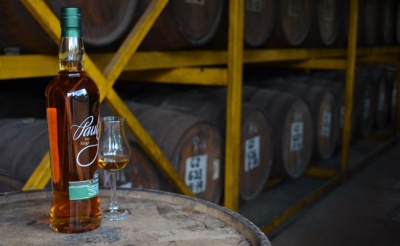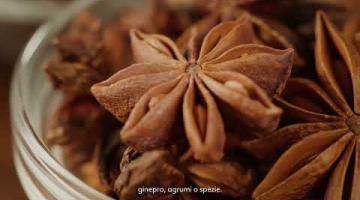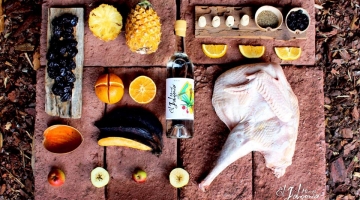Most visitors know Goa — one of the most popular holiday destinations on the west coast of India — for its sun, sea, sand and chorizo-like sausages. But recently, the state added another s-word to its repertoire. Goa’s own single malt whiskey, Paul John Indian Single Malt, has grabbed the attention of whiskey-writers around the world, recently winning a place ahead of Glenmorangie and Laphroaig in Jim Murray’s annual whiskey ratings.
In 2012, India consumed about 1.2 billion liters of whiskey — that’s about half the world’s supply — and studies show that India is the world’s largest whiskey market by volume. And yet, Paul John is only the second single malt whiskey to be produced in the subcontinent.
When you think of single malt, your mind likely drifts to the pristine green landscapes of Scotland, interspersed with glens, natural streams and of course, cooler climes. In other words, absolutely nothing like hot, tropical Goa. With temperatures averaging 30-35 degrees Centigrade (that’s in the upper 80s and 90s Fahrenheit) throughout most of the year, and a humid environment thanks to heavy tropical monsoons, one would imagine it isn’t the most ideal place to make whiskey. Which begs the obvious question: why Goa? Ask Paul John’s master distiller Michael John D’souza, and he’ll rattle off a list of compelling reasons that eventually turns the question on its head: why not Goa?
“Whiskey-making is all about tradition,” he begins. “We follow the traditional methods that depend heavily on the elements – wood, copper, water. Water plays a hugely important role. The purer the water, the better your whiskey is likely to be. But it doesn’t mean you need to set up your distillery in Scotland, where they have naturally occurring streams. That stream water has to be distilled too. You can technically set up a distillery anywhere you have a good water source.”
Goa is known for its high-quality water, and the John Distillery is based in an industrial estate in South Goa, not far from the River Sal, which acts as the primary source of water. The other key ingredients are all sourced 100% locally. The barley comes from the Himalayas, harvested only in summer to ensure maximum maturity. It is a special 6-row barley that has a higher percentage of protein and less carbohydrate, than the 2-row variant typically used in the making of Scotch. This variant yields less extract, because of the higher protein and husk content, but it lends the single malt a rich aroma and complex depth of flavor.
Man toasting with a snifter of Scotch
Michael John D'souza, Paul John's master distiller, says he wanted to create a whiskey that represented the vast diversity of India.
So, what makes Paul John truly, uniquely Indian? (Not to mention good enough to knock some of the global leaders off of Jim Murray’s listings for the year?) “Single malt is a very minimal and modest spirit,” says D’souza. “It uses simple ingredients, yet has complex flavors that develop with age as it absorbs elements and substances from its surroundings,” he explains. “I wanted to create something different. India is massively diverse, and I wanted to produce something that represented that diversity.”
The landscape of Goa is rich with salty flavors from the sea, moist air and deep, and red soil. Its warm temperatures create a perfect place for a uniquely-flavored single malt that matures much faster than anywhere else in the world. The heat also means the distillery faces an angel’s share (the amount of spirit lost to evaporation) of approximately 8% per year. Unlike wine, storing whiskey doesn’t usually involve temperature control. This is because the distinct flavors from one distillery to the next comes from the way the malt interacts with its environment.
At the John Distilleries, for example, the environment in the subterranean warehouse yields an elegant flavor, with earthy but floral notes, while the upper warehouse produces a malt with more robust flavors. The distillery’s location near the sea also adds a touch of saltiness that comes through with a bit of bite.
It’s the vibrant character and spectrum of flavors that make Goa’s malts unique. “You cannot actually compare one whiskey to another because every distillery has got its own style and taste. And that changes based on equipment, methods, and the hand that makes it,” D’souza hastens to add. “Our whiskey matures in wooden barrels with 32 stays from different trees. So each and every barrel gives me a range of flavors. I have more than 8,000 barrels and the flavors range from citrus, honey, vanilla, [and] tropical fruity notes to spicy, smoky tones too.”
Whiskey-making is not new to India; however, it was historically limited to blended whiskey. Single malts are a different ball game that require the perfect meeting of science, technology and the art of making fine blends. “Whiskey-making is 50% science and 50% art, you have to have a flair for it,” D’souza says. “I’ve been traveling abroad, working in distilleries in Scotland for many years now. I love whiskey, and I’ve been doing this for 23 years. Once I learned the technicalities, I had to also make compromises in life to support this. I cannot smoke, I cannot eat spicy food – I have had to change my lifestyle to be able to taste whiskey,” he says.
With single malt consumption growing by 15-20% every year, the horizon is promising for Indian whiskey-makers. And it’s clear that this distillery has settled in for the long haul — in 2014 alone, John Distilleries produced and sold approximately 6,000 cases. The malts are currently available in European markets including the United Kingdom, Germany, France, Denmark, Switzerland, Norway, Finland and Lithuania. Recently introduced in Australia, it will also make its way to North America by the end of the year. The collection, which includes six whiskies, runs a wide gamut of flavor, from spicy to fruity to smoky. No matter what your preference or which you choose, you’ll taste the soul of Goa.
thanks to :https://talesofthecocktail.com/in-depth/story-award-winning-single-malt-...
















